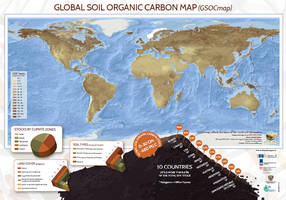The Global Soil Organic Carbon Map, a stepping stone in our knowledge of soils
Knowing our soils will help manage them in a sustainable way, unlock their potentials for mitigating and adapting to climate change and ensure sufficient food production for present and future generations.

Open the GSOCmap web application
Soil organic carbon is the engine of any soil and is essential to ensuring soil health and fertility, food production, but also to mitigating climate change. Maintaining, and especially increasing soil carbon stocks will allow to unlock the soil’s full potential to support mitigation and adaption to a changing climate.
To this end, the first global soil organic carbon map ever produced through a consultative and participatory process involving 110 member countries will be launched on WSD 2017.
The approach adopted to develop the map makes it totally new and unique: member countries were involved in the whole development process of the map, under the guidance of the Intergovernmental Technical Panel on Soils and the GSP Secretariat. Countries agreed on the methodology to produce the map and were trained by the GSP on modern tools and methodologies to develop national maps. The GSP then gathered all national maps to produce this final product, ensuring a thorough harmonization process.
The map presents the current Soil Organic Carbon stock in the first 30 cm of our global soils. In fact, the first 30 cm of soil across the globe holds almost double the amount of carbon present in our atmosphere and dozens of times the levels of man-made emissions each year. That’s why soils constitute the largest organic carbon pool on the Earth and are our silent allies to combat climate change.
The GSOCmap provides users with very useful information to monitor the soil condition, identify degraded areas, set restoration targets, explore SOC sequestration potentials, support the greenhouse gas emission reporting under the UNFCCC and make evidence based decisions to mitigate and adapt to a changing climate.

